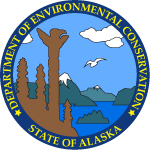| Action Date |
Action |
Description |
DEC Staff |
| 6/4/1991 |
Site Added to Database |
On 24 September, 1999, a Marathon field employee discovered 2 stained soil areas immediately adjacent to, and south of Pad 41-7. Marathon collected 5 soil samples from the stained areas. Marathon has removed the stained surface soil by hand, filling approximately 1.5 55-gallon drums. Groundwater was encountered at approximately 2 inches to 1 foot below ground surface. Contamination appears to be weathered DRO and RRO. |
Donald Seagren |
| 10/7/1999 |
Preliminary Assessment Approved |
Received notification of historic release at site and reviewed preliminary assessment data. Discussed with Bob Menzie of Marathon. |
Donald Seagren |
| 11/22/1999 |
Site Characterization Workplan Approved |
Reviewed and approved work plan. Added GRO analysis for initial round of sampling. Discussed with Menzie of Marathon. If no GRO found, can be dropped from further sampling events. |
Donald Seagren |
| 11/27/1999 |
Site Ranked Using the AHRM |
Surface Water Exposure Index Value changed to 0 by Harwood. |
Donald Seagren |
| 12/9/1999 |
Site Ranked Using the AHRM |
Site reranked. Surface Water Exposure Index Value changed to 1. |
Donald Seagren |
| 12/23/1999 |
Update or Other Action |
Site name changed to "KGF, Pad 41-7, Historic Releases." There is now an off-site and on-site portion to the release. The on-site portion was transferred from PERP on 23 December 99. |
Donald Seagren |
| 3/1/2000 |
Update or Other Action |
Reckey 1999230126701, Site Name changed to "Kenai Gas Fields Pad 41-7, 1999" and is a different spill event than existing Reckey 1986230129401, Site Name "Kenai Gas Fields Pad 41-7, 1986". |
Donald Seagren |
| 5/5/2000 |
Update or Other Action |
Site inspection with Marathon and tour of drilling rig |
Donald Seagren |
| 8/6/2001 |
Site Ranked Using the AHRM |
Reviewed and approved Marathon's request to delay site assessment until the 2002 field season due to conflicts with on-going drilling activities. |
Donald Seagren |
| 1/23/2004 |
Meeting or Teleconference Held |
Meeting with Eric Ward (Marathon). Discussed close out of 03 spill with Folley. Will conduct site inspection in Spring 04 to determine site assessment/monitoring plan for start up in 2004. |
Donald Seagren |
| 3/10/2004 |
Update or Other Action |
File number assigned and entered into the Fileroom DB and CS DB. |
Alyce Hughey |
| 6/24/2004 |
Update or Other Action |
Site inspection to address contamination discovered during pipeline installation. Contaminated soil will be segregated and sampled. Contaminated GW being vacuumed up and disposed down injection well. Additional MW and pad assessment plans being developed. Further discussion on segregating worst contaminated soil with Pete Campbell in PM. |
Donald Seagren |
| 10/19/2004 |
Update or Other Action |
Conference call with Pete Campbell and Eric Ward. Contamination locations marked. No cleanup or assessment of contamination leaving the edge of the pad will be done during pad expansion |
Donald Seagren |
| 3/8/2005 |
Update or Other Action |
Reviewed and approved work plan for the installation of 6 monitor wells off the pad. Installation was coordinated with US Army Corps of Engineers for the work in the adjacent wetlands. |
Donald Seagren |
| 8/30/2005 |
GIS Position Updated |
Using Figure 1 from a Site Characterization Report Kenai Gas Field Pad 41-7, from OASIS Environmental, dated February 3, 2000, in conjunction with TopoZone Pro and the KPB Parcel Lookup. Metadata includes No Topo Basemap, TopoZone Pro Street Maps, Black and White Aerial Photo, on a Medium Size Map. View Scale 1:10,000, Coordinated Datum, NAD83. High degree of confidence in accuracy of location. |
Alyce Hughey |
| 9/13/2005 |
Update or Other Action |
Conference call with Jennifer Satterwhite & Doug Kinnett of marathon to discuss the development of a contaminated soil management plan for the entire field, for contaminated soils discovered during the normal operations & maintenance of the filed. |
Donald Seagren |
| 5/23/2006 |
Update or Other Action |
Reviewed the July 05 Monitoring Well Installation and Sampling report for MWs installed off the pad. Initial sampling indicated GW contamination exceeding ADEC cleanup levels for DRO & RRO. MWs frozen during the winter, precluding a sampling event. Marathon proposed semi-annual sampling in spring & fall. The proposed plan was approved with a modification to sample spring, fall and mid-summer. With the initial sampling event, this will provide 4 data points for each well with which to based any remedial acitons on. Marathon can notify the Deaprtment by email after each sampling event unless some anaomoly comes up requiring immediate attention. All 4 sampling events will then be presented in a single report next fall. |
Donald Seagren |
| 3/9/2007 |
Site Characterization Workplan Approved |
Reviewed and approved site assessment work plan for installation of additional monitor wells on and off the pad. the off pad work needs to be done in the winter to be able to access the surrounding wetlands and not damage them. A USACE permit has been obtained to conduct the work |
Donald Seagren |
| 4/3/2007 |
Update or Other Action |
Initial review of the Contaminated Soil Management plan. Cooordinate review & comments with PERP and USFWS. |
Donald Seagren |
| 4/10/2007 |
Update or Other Action |
Reviewed 06 monitoring report. MWs frozen in March. Further sampling will be on semi annual basis (spring & Fall) to avoid frozen wells. GW flow is to SW with the pad access road acting as a barrier to grondwater flow in the wetlqands surface water. 2 wells exceeded clenaup levels for RRO at least once. One well exceeded cleanu levels for DRO. Oasis Environmental is devleoping a work plan to add 8 monitor wells in the wetlands and 15 soil borings on the pad, with at least 7 of them becoming monitor wells. The additioanl montior wells will be added to the sampling program to provide additional information on pad conditions. |
Donald Seagren |
| 5/16/2007 |
Update or Other Action |
Approved reuse of approximately 450 gallons (8 drums) of drill cuttings from MW installation, as backfill material in the reserve pit on KFG Pad 43-32 |
Donald Seagren |
| 7/17/2007 |
Site Characterization Workplan Approved |
Approved 07 site assessment work plan. The approval included an additional soil boring to define the extent of contamination in the Southern end of the pad. |
Donald Seagren |
| 6/12/2008 |
Update or Other Action |
Site transferred from Don Seagren to Paul Horwath per Linda Nuechterlein. |
Alyce Hughey |
| 6/4/2009 |
Update or Other Action |
On May 22, 2009, while digging a trench to install flowlines for the recently drilled KU 42-6X well at the Kenai Gas Field Pad 41-7, contaminated soil from a previous spill known to be at the facility was incountered. The trench was dug on the south side of Meter Building No. 3, and approximately 18 cubic yards of contaminated soil was excavated and transported to Marathon's Grind and Inject Facility at the Kenai Gas Field. |
Alyce Hughey |
| 6/25/2009 |
Document, Report, or Work plan Review - other |
Reviewed the Kenai Gas Field Pad 41-7 2007/2008 Annual Groundwater Monitoring Report, dated May 8, 2009, from OASIS Environmental for Paul Horwath. The monitoring performed to date indicates that the groundwater beneath the production pad is impacted with natural gas condensate and diesel fuel. The greatest extent of the contamination, with free phase hydrocarbons present, appears to be present beneath the western portion of the production pad in the vicinity of the building infrastructures. Natural attenuation does appear to be occurring and additional monitoring is needed in order to complete the evaluation of Monitored Natural Attenuation conditions for the site is in transition from aerobic to anaerobic. Additional monitoring is also needed in order to fully define the lateral extent of impacts within several areas of the site, and to fully evaluate seasonal effects that would indicate the plume is expanding, stable, or contracting. |
Alyce Hughey |
| 2/14/2012 |
Document, Report, or Work plan Review - other |
Reviewed the 2010 Annual Groundwater Monitoring Report, dated May 18, 2011, from OASIS Environmental. During the 2010 groundwater sampling events, some significant changes in the DRO concentrations occurred within monitoring wells located on the east side of the pad within MW-16 with DRO at 1.4 mg/L in June and 1.6 mg/L in December and within the down-gradient well MW-30 with DRO being detected at 0.95 mg/L in June. Also changes occurred within the monitoring wells located on the western side of the pad within MW-33 with DRO at 13 mg/L in June and 1.6 mg/L in December, within MW-32 with DRO at 1.8 mg/L in June and 8.4 mg/L in December and within MW-17 now having measureable product thickness for the first time of 0.15 feet in June and 0.08 feet in December. The full extent of the hydrocarbon contamination has not been defined, and further assessment/characterization is needed to fully define the extent of the hydrocarbon contamination at the site. Groundwater monitoring will continue to identify the concentration trends within the groundwater. |
Alyce Hughey |
| 8/9/2012 |
Document, Report, or Work plan Review - other |
Reviewed the Groundwater Monitoring Report, Kenai Gas Field Pad 41-7, dated April 1, 2012, prepared by OASIS Environmental. During the 2011 groundwater sampling event, MW-16 located on the eastern side of the pad showed concentrations similar to historical concentrations after the increase was observed in 2010. Monitoring well MW-33 located on the western edge of the pad continues to show an increasing trend in DRO concentrations with 32 mg/L. LNAPL is continuing to migrate and approach the edge of the production pad. With the continued migration of LNAPL, it may overwhelm the natural attenuation on the edge of the pad and off-pad surface water sheens may be seen in the near future. Monitoring well MW-24 contained 4.1 feet of measurable product in 2011. Recommendations included the implementation of the site characterization, routine groundwater monitoring of existing and new monitoring wells, surface water sampling, and interim measures to prevent off-pad migration of LNAPL along the western edge of the pad. |
Alyce Hughey |
| 2/13/2013 |
Document, Report, or Work plan Review - other |
Reviewed the 2012 Groundwater Monitoring Surface Water Monitoring, and Additional Assessment Report, dated January 15, 2013, prepared by Weston Solutions. On May 23, 2012 monitoring well MW-16 was decommissioned. The soil borings and installation of monitoring wells MW-34 through MW-37, replacement wells MW-16R, MW-21R, MW-22R and MW-23R was conducted on May 23, 2012 through May 24, 2012. Soil samples collected detected DRO at 8.5 to 9 feet bgs at 2,960 mg/kg in MW-16R and at 7 to 7.5 feet bgs at 4,110 mg/kg in MW-23R. The first semi-annual groundwater monitoring and surface water sampling event was conducted between May 26, 2012 through May 29, 2012 from 18 groundwater monitoring wells, and from six surface water locations. MW-20 was not sampled because it was frozen and MW-25 was not sampled due to the presence of nesting Terns. Groundwater sample results detected DRO at 1.9 to 10.8 mg/L, RRO at 1.1 to 3.6 mg/L and Benzene at 0.0109 mg/L. Surface water samples detected TAH at 0.003 and TAqH at 0.0039 in all samples collected. The second semi-annual groundwater monitoring and surface water sampling event was conducted between September 26th through September 30, 2012 from 20 groundwater monitoring wells, and from six surface water locations. Groundwater sample results detected DRO at 1.5 to 22.0 mg/L, RRO at 1.2 to 2.5 mg/L and Benzene at 0.005 to 0.0096 mg/L. Surface water samples detected TAH at 0.005 and TAqH at 0.0057 to 0.0065 in samples collected. Decommissioning of monitoring wells MW-21 and MW-22 was conducted on October 24, 2012. Monitoring well MW-23 was not decommissioned in October due to the presence of 0.20 feet of LNAPL in September. LNAPL measured in MW-17 was 0.10 feet in May and 0.05 feet in September. LNAPL measured in MW-24 was 3.98 feet in May and 4.77 feet in September. A monitoring well survey was conducted on June 25, 2012 from McLane Consulting from all site monitoring wells. In September three different plumes were observed. A DRO plume on the eastern edge of the pad, a Benzene, RRO and DRO plume with LNAPL on the southern portion of the pad, and a Benzene, RRO and DRO plume with LNAPL on the western portion of the pad. Additional groundwater monitoring wells are needed to fully characterize the plumes, and to see if only one plume exists on the site. The plume along the western portion of the pad is migrating to the edge of the pad. Continued migration to the west may reduce the effectiveness of the natural attenuation process thought to be active at the edge of the wetland/pad interface and the result of off-pad surface water impact. |
Alyce Hughey |
| 9/18/2013 |
Long Term Monitoring Established |
Annual long term monitoring of GW quality established within Weston Solutions' 2012 Groundwater Monitoring and Sampling Work Plan. |
Paul Horwath |
| 5/12/2015 |
Document, Report, or Work plan Review - other |
Reviewed SLR's Kenai Gas Field Pad 41-7 2013 Groundwater and Surface Water Monitoring Report. Groundwater conditions similar to those reported in the 2012 GW and SW sampling and analysis event. |
Paul Horwath |
| 9/27/2017 |
Document, Report, or Work plan Review - other |
Issued conditional approval of the 2017 GW Monitoring Work Plan, which was prepared for Hilcorp by Brice Environmental. |
Paul Horwath |
| 10/6/2017 |
Site Characterization Workplan Approved |
Approved Brice's 2017 Groundwater Monitoring Work Plan (amended). |
Paul Horwath |
| 12/20/2017 |
Document, Report, or Work plan Review - other |
Review a workplan for the cleaning and sampling of the water well, which was accidently contaminated during operations & maintenance. Workplan prepared by Jacobs Engineering on behalf of Hilcorp Alaska. |
Paul Horwath |
| 7/2/2019 |
Document, Report, or Work plan Review - other |
ADEC approved the 2019 Groundwater Monitoring Program Work Plan, which was prepared by Brice Environmental, as amended by the Brice Environmental June 24th response to ADEC's June 21st work plan review comments. |
Paul Horwath |
| 3/16/2020 |
Document, Report, or Work plan Review - other |
Review the 2019 Groundwater Monitoring Report. It appears that there is a downward potential in the potentiometric surface in monitoring wells that penetrate the peat layer of the pad. When monitoring well MW-24 is replaced, this well should be replaced with two wells, one shallow (less than 11’ BGL) within the peat and one well screened deeper within in the mineral soils. Care should be taken to tremi grout MW-24 from the base out when the well is abandoned. MW-20 should also be evaluated to determine if this well has a downward potential that may contribute to contamination of the lower aquifer. |
Peter Campbell |
| 4/7/2020 |
Document, Report, or Work plan Review - other |
Review the Hilcorp Groundwater Monitoring Well Installation, Decommissioning and Maintenance Plan (Feb. 2020). Plan is approved with the exception of the well abandonment procedure for MW-24. |
Peter Campbell |
| 9/8/2021 |
Risk Assessment Workplan Approved |
Review and approve KGF 2021 work plan. |
Peter Campbell |
| 3/15/2022 |
Document, Report, or Work plan Review - other |
There has historically been a downward potential between the upper pad groundwater (perched aquifer) and groundwater below the pad. Well screens and other features (pipelines and utilities) cross or come close to breaking the apparent boundary retarding downward contaminant flow into the mineral soil aquifer under the pad. Wells that cross the aquitard should be abandoned (MW-27R, MW-21R). The mineral soil aquifer should have a dedicated monitoring network, especially on the western side of the pad, that can detect contaminants moving off pad. An ideal network would include wells just under the peat soils, (dual cased or carefully grouted), in areas of the pad that may be likely to be source areas for contamination. |
Peter Campbell |
| 3/15/2022 |
Workplan Requested |
Request a work plan for abandonment of wells that cross the aquitard of the perched aquifer and for wells monitoring mineral soils groundwater under the pad. |
Peter Campbell |
| 5/16/2023 |
Long Term Monitoring Workplan or Report Review |
Review Draft 2023 Groundwater Monitoring Program Draft Work Plan Addendum and deny work plan approval until a work plan is submitted and approved for the installation of monitoring wells that are screeded in the mineral soils under the pad. This work was requested in 2017, 2020 and 2022. |
Peter Campbell |
| 6/28/2023 |
Site Visit |
Pad inspection with DEC staff, Hilcorp Safety and consultant. Observe monitor well sampling. |
Peter Campbell |
| 10/10/2023 |
Document, Report, or Work plan Review - other |
The 2023.10.6 soil management plan is approved. You should be prepared to encounter free product in the western leg of the 41-7 leg (within the central part of the area defined by the orange line). Marathon installed a monitoring well in the area in the late 90’s that encountered significant free product.
Rather than one long open excavation you might consider earthen dams to prevent movement of product throughout the open excavation.
|
Peter Campbell |
| 10/12/2023 |
Update or Other Action |
During the pipeline trenching, natural gas condensate contaminated soil and water were encountered in the western leg. The majority of the impacted soils were placed back in the excavation. Remaining soils and water were taken to the G&I Facility for disposal. The trench was capped with clean gravel. Requested documentation from Hilcorp, (Letter report and map). |
Peter Campbell |
| 10/31/2023 |
Document, Report, or Work plan Review - other |
DEC received a field report from the excavation of an electrical trench that ran from the west pad entrance road to the northeast near MW-15. As anticipated, shallow water was encountered at about eight inches below the ground surface, and the water had sheen. The electrical trench was excavated with a Supersucker. Impacted soils were returned to the trench. The trench was capped with clean gravel. Impacted water was disposed of at the G&I facility. |
Peter Campbell |
| 3/14/2024 |
Meeting or Teleconference Held |
Meet with Hilcorp to discuss 2024 cathodic protection actions that will involve trenching across 41-7. Hilcorp presented the planned pathway of the trenches. Discussed potential areas of significant soil and groundwater impacts in the trenching path. Hilcorp plans on managing excavation with the same methods established in previous digs. Excavate soils and place next to open trench. If grossly impacted soils are encountered notify DEC. Place impacted soils back into excavation in the order they were removed from the ground ("dirty soils first in and covered with clean soils"). Water will be sent to the Grind and Inject facility. If significant product is encountered, they have been advised to berm the source area trench to stop product from moving over the entire trench. A construction report has been requested to document impacts. Advised Hilcorp that there is a potential for artesian flow in an excavation during high water in springtime. |
Peter Campbell |
| 8/28/2024 |
Meeting or Teleconference Held |
Meeting with Hilcorp (Ferris and Peloza) to discuss the risks of the current pad monitoring wells that may pose a risk to the subsurface minerals soils due to well construction errors. Many pad wells are screened to or through the pad peat layer that seems to be a hydrologic barrier to groundwater flow. I suggested Hilcorp evaluate the well network and consider replacing wells that could be a conduit for contamination from the pad to the underlying mineral soils. Then establish a new well network that looks at the subsurface water quality in mineral soils where contaminants may move freely. |
Peter Campbell |
| 10/15/2024 |
Document, Report, or Work plan Review - other |
Letter to Hilcorp requesting a review of the Pad monitoring well network that may be a liability for impacted monitoring wells being pathways of contamination to the lower mineral soils aquifer. |
Peter Campbell |
| 4/24/2025 |
Long Term Monitoring Workplan or Report Review |
Review and approve the 2025 Work Plan Addendum dated April 3, 2025. |
Peter Campbell |




